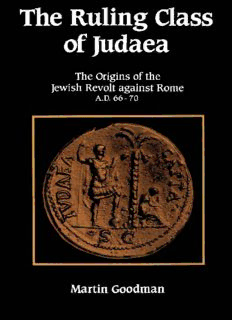
The Ruling Class of Judaea: The Origins of the Jewish Revolt against Rome, A.D. 66-70 PDF
Preview The Ruling Class of Judaea: The Origins of the Jewish Revolt against Rome, A.D. 66-70
THE RULING CLASS OF JUDAEA This book examines why in A.D. 66 a revolt against Rome broke out in Judea. It attempts to explain both the rebellion itself and its temporary success by discussing the role of the Jewish ruling class in the sixty years preceding the war and within the in dependent state which lasted until the destruction of the Temple in A.D. 70. The author seeks to show that important fac tors such as economic distress and religious ideology were not a sufficient cause of the outbreak of the revolt, and that a crucial factor previously overlooked was the decision of some factions of the ruling class to cut ties with Rome and seek power for them selves. That decision is itself ascribed to the fact that Jewish rulers of Judaea, having been selected in accordance with non- Jewish status criteria, failed to fulfil the role the Romans expected of them and, losing Roman support for their power during the sixties A.D., appealed to latent anti-gentile prejudices in the rest of the local population in order to preserve their own position. The importance of the subject lies both in the significance of the history of Judaea in this period for the development of Judaism and early Christianity and in the light shed on Roman methods of provincial administration in general by understand ing why Rome was unable to control a society with cultural values so different from its own, both in Judaea and, as the last chapter briefly discusses, in the treatment of druids in Gaul. Dr Goodman is eminently well qualified to write this book, being as at home with the Jewish texts as he is with the Greek and Latin authors. It is a book for ancient historians studying Roman history and Jewish history and will be of interest to theologians studying the background to the life of Jesus. THE R U L I NG GLASS OF J U D A EA THE ORIGINS OF THE JEWISH R E V O LT 66-70 AGAINST ROME A.D. MARTIN GOODMAN CAMBRIDGE UNIVERSITY PRESS CAMBRIDGE NEW YORK PORT CHESTER MELBOURNE SYDNEY Published by the Press Syndicate of the University of Cambridge The Pitt Building, Trumpington Street, Cambridge CB2 IRP 35 East 57th Street, New York, NY 10022, USA 10 Stamford Road, Oakleigh, Melbourne 3166, Australia © Cambridge University Press 1987 First published 1987 Reprinted 1988, 1989 Printed in Great Britain at the University Press, Cambridge British Library cataloguing in publication data Goodman, Martin The ruling class ofjudaea: the origins of the Jewish revolt against Rome A.D. 66-70. 1. Jews—History—Rebellion, 66-73. I. Title 933'°5 DS122.8 Library of Congress cataloguing in publication data Goodman, Martin The ruling class ofjudaea. Bibliography. Includes index. 1. Jews—History—Rebellion, 66-73—Causes. 2. Jews—Politics and government—To A.D. 70. 3. Political leadership—Palestine—History. 4. Jews—History— 168 B.C.-135 A.D. I. Title. DSI22.8.G66 1987 933'-05 87-6656 ISBN o 521 33401 2 EA For C J.G. and R.G. v C O N T E N TS Abbreviations ix Preface xi Maps xii-xiii 1 Introduction i (i) The problem i (ii) The conventional explanations 5 (iii) Civil war, the ruling class and revolt 14 PART I THE RULING CLASS A.D. 6~66 27 2 The new ruling class A.D. 6 29 3 Problems facing the ruling class: economic and social 51 4 Problems facing the ruling class: religious ideology 76 5 Why the ruling class failed 109 PART II FACTION STRUGGLE WITHIN THE RULING CLASS 135 6 Reactions to failure: the ruling class A.D. 6-66 137 7 The outbreak of revolt 152 8 The independent Jewish state A.D. 67-70 176 9 Trends in faction politics A.D. 50-70 198 PART III THE AFTERMATH OF THE REVOLT 229 i o The Roman reaction 231 Select bibliography 252 Index 257 vii A B B R E V I A T I O NS A.J. Josephus, Antiquitates Judaicae b. Babylonian Talmud B.J. Josephus, Bellum Judaicum BMC Catalogue of the Greek Coins in the British Museum, 29 vols., London,1873-1927 BMCRE H. Mattingly and R. A. G. Carson, eds., Coins of the Roman Empire in the British Museum, 9 vols., 1923-75 c.Ap. Josephus, contra Apionem CHJ W. D. Davies and L. Finkelstein, eds., The Cambridge His tory of Judaism, 4 vols., Cambridge 1984- cij Corpus Inscriptionum Iudaicarum CIL Corpus Inscriptionum Latinarum CPJ V. Tcherikover, A. Fuks and M. Stern, Corpus Papyrorum Judaicarum, 3 vols., Cambridge, Mass., 1957-64 DJD2 P. Benoit, J. T. Milik and R. de Vaux, Les Grottes de Murabba'at (Discoveries in the Judaean Desert 11) (Oxford, i960) E.T. English translation FGrH, Jacoby F. Jacoby, Fragmente der griechischen Historiker, 1923- Heb. Hebrew IGR R. Cagnat, ed., Inscriptions Graecae ad res Romanas perti- nentes, vols. 1, in, iv, Paris, 1906-27 ILS H. Dessau, Inscriptions Latinae Selectae, Berlin, 1892-1916 m. Mishnah OGIS W. Dittenberger, ed., Orientis Graeci Inscriptiones Selectae, 2 vols., Leipzig, 1903-5 POxy. Oxyrhynchus Papyri, ed. B. P. Grenfell and A. S. Hunt, 1898- iQapGen. Genesis Apocryphon, in K. Beyer, Die aramaischen Texte vom Toten Meer (Gottingen, 1984), pp. 165-86 4QpPs Commentary on Psalms, in J. M. Allegro, ed., Qumran Cave 4 (Discoveries in the Judaean Desert of Jordan v) (Oxford, 1968), no. 171 iQS Community Rule, in E. Lohse, Die Texte von Qumran hebraisch unddeutsch, 2nd edn (Darmstadt, 1971), pp. 1-43 ix
Description: